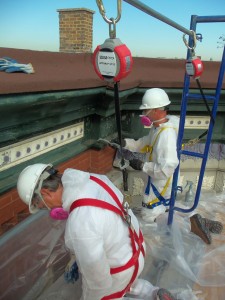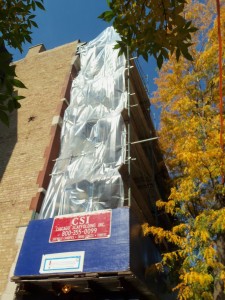EPA’s RRP rules define the principles to follow to ensure a lead-safe painting project involving buildings built prior to 1978. Our paint restoration project on the façade of this 1889 vintage Chicago building surely fell into this category. Outlined below are the steps we followed to comply to the requirements of the RRP rules on this high visibility exterior painting project.
RRP rules layout the principles, but do not get into the specifics of how to comply to the rules. Their intent is to ensure containment of the dust and debris, so that the workers, the public and the environment are protected from the harmful effects of old lead paint. Consequently, depending on the specific conditions of each project, work practices must be devised that will ensure the containment of the dust and debris.
In the case of our Chicago historical restoration project, almost all our work took place above a busy sidewalk, on a canopy and four layers of scaffolding above it. One of the first measures we took was to build a 4-mil, plastic shield on both ends of the scaffold, from top to bottom in order to prevent debris from falling out of the scaffold area. We then sealed the floor of the canopy using heavy-duty blue taps. Contrary to plastic sheeting, blue tarps are not slippery, which is an important safety factor in selecting floor containment materials. Every work area was then sealed with 4-mil plastic sheeting to capture the debris, as it was generated by the carbide wet scraping and wet sanding. To protect our painters from the dust, we used full-body coveralls and P-100 respirators.
Following RRP rules on interior and exterior paint restoration projects is critical to ensure the safety of everyone involved. As a Lead-Safe Firm, we are committed to fulfill the intent of EPA rules on all our painting projects.









 Follow
Follow
